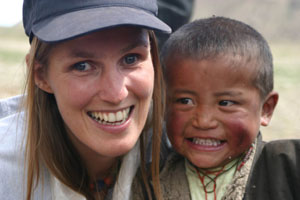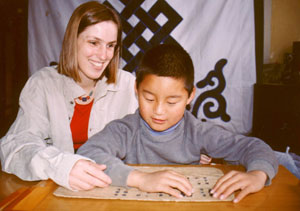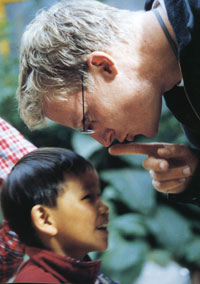Source: CCTV.com
08-01-2006 15:23
 |
Under a brilliant blue sky and a vibrant landscape, the blind children of Tibet live in arguably one of the most beautiful and colorful regions in the world, although they cannot see it themselves. But today, as a result of our two guests' selfless efforts, color is being brought back to the lives of these children at a school for the blind in Tibet. Together with a powerful spirit, Sabriye Tenberken and Paul Kronenberg have defied all odds to transform these once abandoned children into self-sufficient contributors of their communities.
Sabriye was born in a town near Bonn in Germany. She was born with impaired vision, but was still able to make out faces and landscapes until she completely lost her sight at 12. She was sent to a special school for blind children, graduated as a top student and was accepted by Bonn University as a major in Central Asian Studies. With a longtime interest in Tibet, she studied Tibetology in university, and after discovering there was no system of Braille in Tibetan, she developed one.
 |
In 1997, she fulfilled her ambition of traveling to the challenging and mysterious plateau - Tibet. But instead of feeling excitement, she was shocked and deeply concerned by the fact that blind people in Tibet have no access to education and rehabilitation. Although Tibet has a large incidence of blindness, the blind are ostracized because blindness is regarded as punishment for faults committed in previous lives. Thus, Sabriye decided to start a project for the blind in Tibet. But her resolution and enthusiasm couldn't melt other people's suspicions. After being turned down for support several times, Sabriye decided to do it on her own. Her dream was later shared by Paul Kronenberg, a Dutch man who she met on her first trip to Tibet. With his technical background, Paul is responsible for all technical aspects and maintenance of their program "Braille Without Borders".
 |
In May 1998, Sabriye and Paul established the Rehabilitation and Training Center for the Blind in downtown Lhasa. Starting with 6 children from different villages in Tibet, there are now nearly 50 students and 12 teaching and administrative staff in the school. In class, the students not only learn Tibetan, Mandarin, English, mathematics and computer skills, but also receive intensive training in daily living skills, such as orientation, walking with a cane and even cooking. Moreover, they are provided with vocational or skills training including medical massage, musical training and animal husbandry. But the most important thing they learn here is not reading or writing, but self-confidence. They are happy and capable children - a daily testament that with the proper training and love, even blindness can be overcome.
-- Written by Chai Haoran
Editor:Chen

